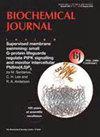Anionic lipids modulate the membrane localization and conformational dynamics of KirBac1.1 slide helix during lipid-dependent activation.
IF 4.3
3区 生物学
Q2 BIOCHEMISTRY & MOLECULAR BIOLOGY
引用次数: 0
Abstract
Inward-rectifier potassium (Kir) channels are essential for regulating various physiological processes and are implicated in several life-threatening diseases, making them key drug targets. KirBac1.1, a well-characterized prokaryotic homolog of Kir channels, is known to undergo anionic lipid-dependent gating. Although the slide helix is an important structural component in the gating mechanism of KirBac1.1, its structural dynamics associated with the anionic lipid-driven activation is not well-understood. Here, we have reconstituted KirBac1.1 in zwitterionic POPC and anionic POPC/POPG membranes to stabilize the inactive and active conformations of the channel, respectively. Our liposome K+ flux assay results show that all the slide helix single-cysteine mutants display PG-driven gating, and increasing the PG from 25 to 40 mol% does not have any linear dependency on both the activation and K+ flux rates. Site-directed NBD fluorescence results suggest that the structural dynamics of the slide helix is significantly altered upon PG-induced activation. For instance, we observe significant changes in hydration dynamics and rotational mobility of slide helix residues between functional states. MEM-based lifetime distribution analysis suggests that the conformational heterogeneity of the slide helix is functional-state dependent. Importantly, membrane penetration depth measurements reveal that the slide helix in the active KirBac1.1 is located ~3 Å deeper within the membrane interface, well supported by increased fluorescence lifetimes. Notably, the non-linear relationship between structural dynamics and PG content highlights the critical role of lipid-protein interactions and membrane surface charge in PG-mediated KirBac1.1 activation. These findings provide valuable insights into Kir channel gating mechanisms, and lipid-dependent gating of other channels.阴离子脂质在脂质依赖激活过程中调节KirBac1.1滑动螺旋的膜定位和构象动力学。
内向整流钾(Kir)通道在调节各种生理过程中至关重要,并与几种危及生命的疾病有关,使其成为关键的药物靶点。KirBac1.1是一种具有良好特征的Kir通道的原核同源物,已知可进行阴离子脂质依赖性门控。虽然滑动螺旋是KirBac1.1门控机制中的重要结构成分,但其与阴离子脂质驱动激活相关的结构动力学尚不清楚。在这里,我们在两性离子POPC和阴离子POPC/POPG膜中重构了KirBac1.1,分别稳定了通道的非活性构象和活性构象。我们的脂质体K+通量分析结果表明,所有的滑动螺旋单半胱氨酸突变体都显示PG驱动的门控,并且将PG从25 mol%增加到40 mol%与激活率和K+通量率没有任何线性关系。位点定向NBD荧光结果表明,在pg诱导激活后,滑动螺旋的结构动力学发生了显著改变。例如,我们观察到滑动螺旋残基在功能状态之间水化动力学和旋转迁移率的显著变化。基于微机电的寿命分布分析表明,滑动螺旋的构象不均匀性与功能态有关。重要的是,膜穿透深度测量显示,活性KirBac1.1中的滑动螺旋位于膜界面内约3 Å深,很好地支持了荧光寿命的增加。值得注意的是,结构动力学与PG含量之间的非线性关系突出了脂蛋白相互作用和膜表面电荷在PG介导的KirBac1.1激活中的关键作用。这些发现为Kir通道门控机制和其他通道的脂质依赖性门控提供了有价值的见解。
本文章由计算机程序翻译,如有差异,请以英文原文为准。
求助全文
约1分钟内获得全文
求助全文
来源期刊

Biochemical Journal
生物-生化与分子生物学
CiteScore
8.00
自引率
0.00%
发文量
255
审稿时长
1 months
期刊介绍:
Exploring the molecular mechanisms that underpin key biological processes, the Biochemical Journal is a leading bioscience journal publishing high-impact scientific research papers and reviews on the latest advances and new mechanistic concepts in the fields of biochemistry, cellular biosciences and molecular biology.
The Journal and its Editorial Board are committed to publishing work that provides a significant advance to current understanding or mechanistic insights; studies that go beyond observational work using in vitro and/or in vivo approaches are welcomed.
Painless publishing:
All papers undergo a rigorous peer review process; however, the Editorial Board is committed to ensuring that, if revisions are recommended, extra experiments not necessary to the paper will not be asked for.
Areas covered in the journal include:
Cell biology
Chemical biology
Energy processes
Gene expression and regulation
Mechanisms of disease
Metabolism
Molecular structure and function
Plant biology
Signalling
 求助内容:
求助内容: 应助结果提醒方式:
应助结果提醒方式:


